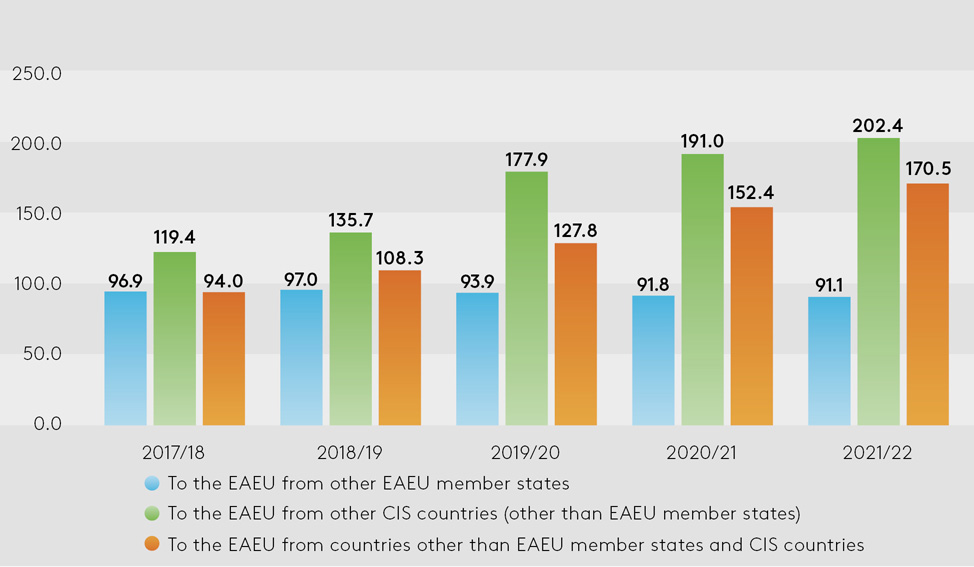The EDB working paper contains a comprehensive analysis of problems and specific practical solutions to ensure the sustainable growth of interuniversity relations and educational exchanges across the Eurasian region (the EAEU and CIS countries).
The strengthening of mutual educational ties among Eurasian countries, ranging from exchange of school and university students, post-graduates, and professors, to alignment of curricula and mutual recognition of diplomas, is an essential sustainable development and regional cooperation tool. In this regard, the working paper proposes the launch of a large Eurasian academic mobility programme and provides a detailed description of the conditions, including an assessment of the costs and opportunities of involving tens and hundreds of thousands of students, scientists and teachers in interuniversity exchange events within the Eurasian region.
Academic mobility in the Eurasian Economic Union (EAEU) member states is currently showing a weakly negative trend. For example, while in 2017–2018 the number of EAEU university students who had arrived from other member states was 96,900, in 2021–2022 it dropped to 91,100. On the other hand, the inflow of students from other CIS countries and the rest of the world states to EAEU universities gradually increased, illustrating the excellent prospects for expanding research and academic exchanges and projects to include countries beyond the EAEU perimeter.
Number of Students of EAEU-Based Universities Arriving from Other Countries, 2017–2022 (as at the beginning of the academic year; thousands of people)

To fully realise the academic mobility potential of the Eurasian region, it is proposed to launch a large-scale Eurasian interstate academic mobility programme, targeted on annual enrolment figures amounting to dozens of thousands of students, post-graduates, and professors. It can be structured as a system of grants that will fully or partially cover education costs (for 1–2 semesters) in the participating country.
Funds should be disbursed through multiple channels, with education costs allocated among the family (for travel), the university, and the state (for study and living) in varying proportions subject to family income and mobility vector — the remoteness of, and cost of living in, the host country. This approach will significantly reduce budget expenditures. Budget expenditures per 1,000 students are estimated at about USD 3.9 million (RUB 360 million or KZT 1.8 billion), the calculation model is given in the working paper.
The priority of the Eurasian academic mobility programme could be training of qualified engineering personnel for cutting-edge industries, primarily to support construction, effective operation and security of cross-border infrastructure facilities, especially in the sectors that have uniform standards (railway transport, electricity networks, oil and gas sector, mechanical engineering).
Another potentially important priority is to train teachers of the Russian language as the official language, or one of the official languages, of a number of international organisations. The Russian language is the basis for multicultural communication and co-operation in the Eurasian region, and its use is hampered by a critical shortage of skilled personnel.
The programme should be structured as a consortium of the leading member-state universities, receiving support from the business community and making use of innovative academic and corporate infrastructure facilities. Private and state-owned companies willing to support the programme could be granted special privileges. An option whereby participants could concurrently engage in theoretical studies and on-the-job training could boost the programme’s efficiency and provide a strong link to “down-to-earth” economic tasks.
The optimal legal and regulatory basis for the academic exchange programme could be provided by a separate intergovernmental agreement going beyond the EAEU framework, as co-operation in the sphere of education is not subject to supranational regulation in the Eurasian Economic Union. If there is mutual interest, new countries could subsequently accede to the agreement.
For the success of the proposed programme, it seems extremely important for the partner universities to execute an agreement that will guarantee recognition of the points (credits) earned by students during their studies abroad. This could give an additional impetus to alignment of curricula and mutual recognition of diplomas in the participating countries.
Finally, a large-scale Eurasian academic mobility programme will contribute to establishment of educational exchanges between countries that have concluded free trade and other agreements and memoranda with the EAEU. It could serve as an important structural element for stimulating trade and economic ties, other areas of scientific, technical and humanitarian cooperation, as well as cooperation in the fields of education and science.
You can view the working paper Academic Mobility Promotion Programme at the EDB website.